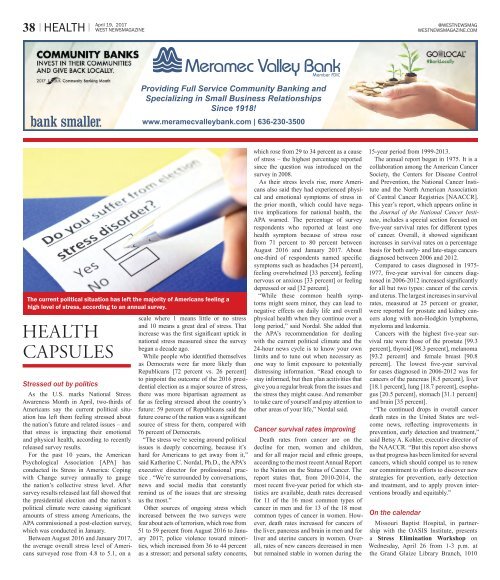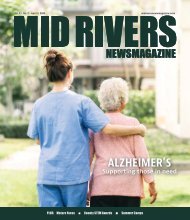West Newsmagazine 4-19-17
Local news, local politics and community events for West St. Louis County Missouri.
Local news, local politics and community events for West St. Louis County Missouri.
You also want an ePaper? Increase the reach of your titles
YUMPU automatically turns print PDFs into web optimized ePapers that Google loves.
38 I HEALTH I<br />
April <strong>19</strong>, 20<strong>17</strong><br />
WEST NEWSMAGAZINE<br />
@WESTNEWSMAG<br />
WESTNEWSMAGAZINE.COM<br />
The current political situation has left the majority of Americans feeling a<br />
high level of stress, according to an annual survey.<br />
health<br />
capsules<br />
Stressed out by politics<br />
As the U.S. marks National Stress<br />
Awareness Month in April, two-thirds of<br />
Americans say the current political situation<br />
has left them feeling stressed about<br />
the nation’s future and related issues – and<br />
that stress is impacting their emotional<br />
and physical health, according to recently<br />
released survey results.<br />
For the past 10 years, the American<br />
Psychological Association [APA] has<br />
conducted its Stress in America: Coping<br />
with Change survey annually to gauge<br />
the nation’s collective stress level. After<br />
survey results released last fall showed that<br />
the presidential election and the nation’s<br />
political climate were causing significant<br />
amounts of stress among Americans, the<br />
APA commissioned a post-election survey,<br />
which was conducted in January.<br />
Between August 2016 and January 20<strong>17</strong>,<br />
the average overall stress level of Americans<br />
surveyed rose from 4.8 to 5.1, on a<br />
scale where 1 means little or no stress<br />
and 10 means a great deal of stress. That<br />
increase was the first significant uptick in<br />
national stress measured since the survey<br />
began a decade ago.<br />
While people who identified themselves<br />
as Democrats were far more likely than<br />
Republicans [72 percent vs. 26 percent]<br />
to pinpoint the outcome of the 2016 presidential<br />
election as a major source of stress,<br />
there was more bipartisan agreement as<br />
far as feeling stressed about the country’s<br />
future: 59 percent of Republicans said the<br />
future course of the nation was a significant<br />
source of stress for them, compared with<br />
76 percent of Democrats.<br />
“The stress we’re seeing around political<br />
issues is deeply concerning, because it’s<br />
hard for Americans to get away from it,”<br />
said Katherine C. Nordal, Ph.D., the APA’s<br />
executive director for professional practice<br />
. “We’re surrounded by conversations,<br />
news and social media that constantly<br />
remind us of the issues that are stressing<br />
us the most.”<br />
Other sources of ongoing stress which<br />
increased between the two surveys were<br />
fear about acts of terrorism, which rose from<br />
51 to 59 percent from August 2016 to January<br />
20<strong>17</strong>; police violence toward minorities,<br />
which increased from 36 to 44 percent<br />
as a stressor; and personal safety concerns,<br />
which rose from 29 to 34 percent as a cause<br />
of stress – the highest percentage reported<br />
since the question was introduced on the<br />
survey in 2008.<br />
As their stress levels rise, more Americans<br />
also said they had experienced physical<br />
and emotional symptoms of stress in<br />
the prior month, which could have negative<br />
implications for national health, the<br />
APA warned. The percentage of survey<br />
respondents who reported at least one<br />
health symptom because of stress rose<br />
from 71 percent to 80 percent between<br />
August 2016 and January 20<strong>17</strong>. About<br />
one-third of respondents named specific<br />
symptoms such as headaches [34 percent],<br />
feeling overwhelmed [33 percent], feeling<br />
nervous or anxious [33 percent] or feeling<br />
depressed or sad [32 percent].<br />
“While these common health symptoms<br />
might seem minor, they can lead to<br />
negative effects on daily life and overall<br />
physical health when they continue over a<br />
long period,” said Nordal. She added that<br />
the APA’s recommendation for dealing<br />
with the current political climate and the<br />
24-hour news cycle is to know your own<br />
limits and to tune out when necessary as<br />
one way to limit exposure to potentially<br />
distressing information. “Read enough to<br />
stay informed, but then plan acitivities that<br />
give you a regular break from the issues and<br />
the stress they might cause. And remember<br />
to take care of yourself and pay attention to<br />
other areas of your life,” Nordal said.<br />
Cancer survival rates improving<br />
Death rates from cancer are on the<br />
decline for men, women and children,<br />
and for all major racial and ethnic groups,<br />
according to the most recent Annual Report<br />
to the Nation on the Status of Cancer. The<br />
report states that, from 2010-2014, the<br />
most recent five-year period for which statistics<br />
are available, death rates decreased<br />
for 11 of the 16 most common types of<br />
cancer in men and for 13 of the 18 most<br />
common types of cancer in women. However,<br />
death rates increased for cancers of<br />
the liver, pancreas and brain in men and for<br />
liver and uterine cancers in women. Overall,<br />
rates of new cancers decreased in men<br />
but remained stable in women during the<br />
15-year period from <strong>19</strong>99-2013.<br />
The annual report began in <strong>19</strong>75. It is a<br />
collaboration among the American Cancer<br />
Society, the Centers for Disease Control<br />
and Prevention, the National Cancer Institute<br />
and the North American Association<br />
of Central Cancer Registries [NAACCR].<br />
This year’s report, which appears online in<br />
the Journal of the National Cancer Institute,<br />
includes a special section focused on<br />
five-year survival rates for different types<br />
of cancer. Overall, it showed significant<br />
increases in survival rates on a percentage<br />
basis for both early- and late-stage cancers<br />
diagnosed between 2006 and 2012.<br />
Compared to cases diagnosed in <strong>19</strong>75-<br />
<strong>19</strong>77, five-year survival for cancers diagnosed<br />
in 2006-2012 increased significantly<br />
for all but two types: cancer of the cervix<br />
and uterus. The largest increases in survival<br />
rates, measured at 25 percent or greater,<br />
were reported for prostate and kidney cancers<br />
along with non-Hodgkin lymphoma,<br />
myeloma and leukemia.<br />
Cancers with the highest five-year survival<br />
rate were those of the prostate [99.3<br />
percent], thyroid [98.3 percent], melanoma<br />
[93.2 percent] and female breast [90.8<br />
percent]. The lowest five-year survival<br />
for cases diagnosed in 2006-2012 was for<br />
cancers of the pancreas [8.5 percent], liver<br />
[18.1 percent], lung [18.7 percent], esophagus<br />
[20.5 percent], stomach [31.1 percent]<br />
and brain [35 percent].<br />
“The continued drops in overall cancer<br />
death rates in the United States are welcome<br />
news, reflecting improvements in<br />
prevention, early detection and treatment,”<br />
said Betsy A. Kohler, executive director of<br />
the NAACCR. “But this report also shows<br />
us that progress has been limited for several<br />
cancers, which should compel us to renew<br />
our commitment to efforts to discover new<br />
strategies for prevention, early detection<br />
and treatment, and to apply proven interventions<br />
broadly and equitably.”<br />
On the calendar<br />
Missouri Baptist Hospital, in partnership<br />
with the OASIS Institute, presents<br />
a Stress Elimination Workshop on<br />
Wednesday, April 26 from 1-3 p.m. at<br />
the Grand Glaize Library Branch, 1010

















